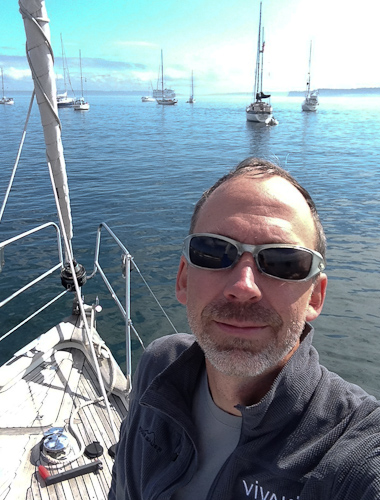Solo September Sail - Part One

| Seaquester Home | Part Two |

I first started sailing in 2003 when I purchased a 27’ Catalina sloop and started fixing her up. Early trips with Gata Luna were full of adventure and as I gained confidence on the water I ranged wider and wider. Now, many years later, I have a bigger boat (and a bigger family) but we still enjoy spending time in the islands and typically take one big trip together every summer.
This summer was a little different in that we did not take our usual long boat trip north. Family and work commitments kept us in the city and it was quickly September. After finishing a large project at work, I saw a weather window appear for a week of sunshine as high pressure built up over the pacific northwest. I figured this might be the last good weather of the summer and decided to squeeze in a sailing trip. My daughter was back at school and my wife involved in projects at work. My friends were busy as well, so it would be a solo trip. I figured this was a good chance to hone my skills as a sailor and explore some new anchorages. So with minimal prep, I left Seattle on a Friday evening with a friend to get through the locks. Docked in Shilshole, just outside the locks, my friend headed home and I went to sleep early so I could start my trip at dawn to catch the tides north.
As with previous travelogues I will try to let the photos tell the story of my journey (click on the photos to zoom them.)
 Port Townsend
Port TownsendI was in Port Townsend for the Wooden Boat Festival. This annual event brings wooden boats (and boat lovers) from all over the west coast. Having spent my fair share of hours working on boats, it is humbling to see the before and after photos of some of these boats. Many are restored to perfection with solid hulls, mirror smooth varnish and polished brass representing thousands of hours of work. It takes a certain kind of person to devote that much time to perfecting a boat. I understand these people and admire their passion. Since the marinas are full of vessels from the show, visiting boats are forced to anchor off of town. In years past when I anchored among the crowds, I’ve woken in the night when boats started banging together as the wind shifted. This time I was wary and anchored out past most of the boats near the ferry dock. I had a long way to row to the dingy dock but I slept easier (although exposed to ferry and freighter wash, the anchorage is fairly rolly.) |
Copyright 2013
Scott Semyan